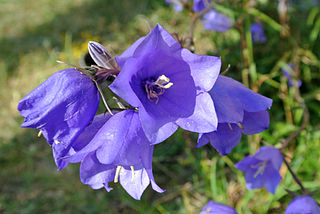
Campanula is the type genus of the Campanulaceae family of flowering plants. Campanula are commonly known as bellflowers and take both their common and scientific names from the bell-shaped flowers—campanula is Latin for "little bell".

The family Campanulaceae, of the order Asterales, contains nearly 2400 species in 84 genera of herbaceous plants, shrubs, and rarely small trees, often with milky sap. Among them are several familiar garden plants belonging to the genera Campanula (bellflower), Lobelia, and Platycodon (balloonflower). Campanula rapunculus and Codonopsis lanceolata are eaten as vegetables. Lobelia inflata, L. siphilitica and L. tupa and others have been used as medicinal plants. Campanula rapunculoides may be a troublesome weed, particularly in gardens, while Legousia spp. may occur in arable fields.
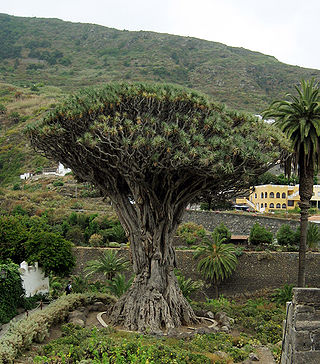
Dracaena draco, the Canary Islands dragon tree or drago, is a subtropical tree in the genus Dracaena, native to the Canary Islands, Cape Verde, Madeira, western Morocco, and possibly introduced into the Azores.
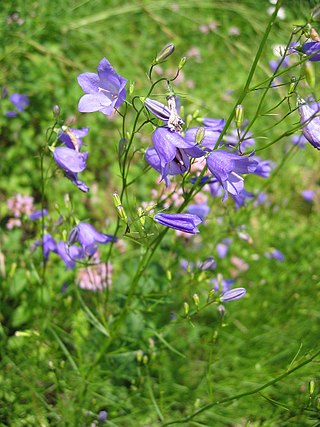
Campanula rotundifolia, the common harebell, Scottish bluebell, or bluebell of Scotland, is a species of flowering plant in the bellflower family Campanulaceae. This herbaceous perennial is found throughout the temperate regions of the northern hemisphere. In Scotland, it is often known simply as bluebell. It is the floral emblem of Sweden where it is known as small bluebell. It produces its violet-blue, bell-shaped flowers in late summer and autumn.

Laurus is a genus of evergreen trees or shrubs belonging to the laurel family, Lauraceae. The genus contains three or more species, including the bay laurel or sweet bay, L. nobilis, widely cultivated as an ornamental plant and a culinary herb.

Sonchus is a genus of flowering plants in the tribe Cichorieae within the family Asteraceae and are commonly known as sow thistles. Sowthistles are annual, biennial or perennial herbs, with or without rhizomes and a few are even woody.

Pericallis is a small genus of 15 species of flowering plants in the family Asteraceae, native to the Canary Islands, Madeira and Azores. The genus includes herbaceous plants and small subshrubs. In the past, the genus was often included in either Cineraria or Senecio.
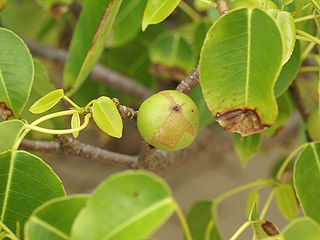
Hippomane is a genus of plants in the Euphorbiaceae described by Linnaeus in 1753. It is native to the West Indies, Central America, Mexico, Florida, Venezuela, Colombia, and Galápagos.
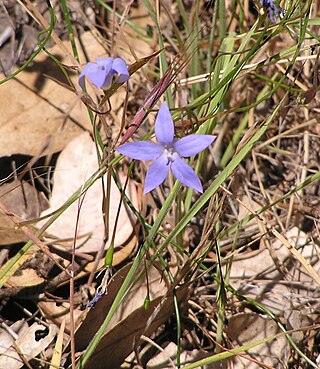
Wahlenbergia is a genus of around 260 species of flowering plants in the family Campanulaceae. Plants in this genus are perennial or annual herbs with simple leaves and blue to purple bell-shaped flowers, usually with five petals lobes. Species of Wahlenbergia are native to environments on all continents except North America, and on some isolated islands, but the greatest diversity occurs in the Southern Hemisphere.

Echium is a genus of flowering plants in the family Boraginaceae that contains about 70 species and several subspecies.

Triodanis is a genus of flowering plants within the family Campanulaceae, native to North and South America. Venus' looking-glass is a common name for plants in this genus.

Butia is a genus of palms in the family Arecaceae, native to the South American countries of Brazil, Paraguay, Uruguay and Argentina. Many species produce edible fruits, which are sometimes used to make alcoholic beverages and other foods. The name is derived from a Brazilian vernacular word for members of the genus.

Sideroxylon mirmulano, commonly known as marmulano, is a species of flowering plants in the family Sapotaceae. It is endemic to the Madeira Islands (Portugal). It is threatened by habitat loss.
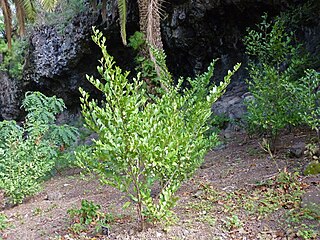
Visnea is a monotypic genus of flowering plants in family Pentaphylacaceae. The genus contains a single species, Visnea mocanera a tree native to the Canary Islands and Madeira.

Sclerotheca is a genus of plants native to various islands in the South Pacific. Nine of the ten known species are French Polynesia, the tenth to Rarotonga in the Cook Islands.
- Sclerotheca arborea(G.Forst.) DC - Tahiti
- Sclerotheca forsteriDrake - Moorea, Tahiti
- Sclerotheca jayorumJ.Raynal - Tahiti
- Sclerotheca longistigmataF.Br. - Marquesas
- Sclerotheca margaretaeR.Br. - Rapa
- Sclerotheca magdalenaeJ.Florence - Tahiti
- Sclerotheca oreadesE.Willm. - Tahiti
- Sclerotheca raiateensis(Baill.) Pillon & Florence - Raiatea
- Sclerotheca seigelii(Florence) Pillon & Florence - Marquesas
- Sclerotheca viridifloraCheeseman - Rarotonga

Solenopsis is a genus of plants in the Campanulaceae. It is native to the Mediterranean region from Portugal and the Canary Islands east to Turkey.

Theilera is a genus of plants in the Campanulaceae. It contains two known species, both endemic to Cape Province of South Africa.
Ian Charleson Hedge was a Scottish botanist at the Royal Botanic Gardens in Edinburgh. Hedge made important contributions to the flora of Iran and Iraq, and was a recognised authority on the flora of south-west Asia. He named more than 300 new plant species.

Musschia aurea, is a species of flowering plant in the Campanulaceae family. It is endemic to the Madeira Islands, including Madeira and the Desertas. It grows on sea cliffs and rocky offshore islets.

Rubus × suspiciosus is a naturally-occurring hybrid species of flowering plant in the blackberry genus Rubus, family Rosaceae, native to Madeira and the Canary Islands. Its parents are thought to be Rubus bollei and R. ulmifolius.




















